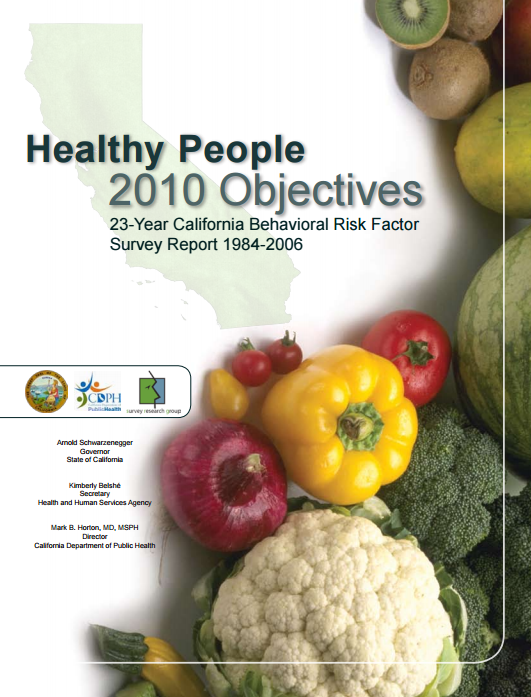
Healthy People 2010 Objectives: 23-Year California Behavioral Risk Factor Survey Report 1984-2006
- Seth Wayland, Bonnie Davis

 The California Behavioral Risk Factor Survey (BRFS) has operated continuously for the last 23 years, collecting health surveillance information from a cross section of the California non-institutionalized adult population with telephones in their households. This report summarizes a small portion of the many topics that have been included in the BRFS.
The California Behavioral Risk Factor Survey (BRFS) has operated continuously for the last 23 years, collecting health surveillance information from a cross section of the California non-institutionalized adult population with telephones in their households. This report summarizes a small portion of the many topics that have been included in the BRFS.
Results of interest include
- Obesity prevalence among adults 20 and older has increased almost every year since 1985, from 7.9 percent to a high of 23.5 percent in 2003. Meanwhile, the prevalence of healthy weight has decreased from a high of 56.9 percent in 1984 to 35.2 percent in 2005.
- The percentage of adults who participate in vigorous physical exercise has met the Healthy People 2010 (HP) objective of 30 percent in 2005 and 2006, and the percentage of adults who engage in moderate exercise has also met the HP objective of 30 percent since 2001 when the question was first asked. The prevalence of adults who participate in no leisure physical activity has varied since 1984, with a high of 30.7 percent in 1985 and a low of 21.8 percent in 2003.
- Since 1991, the percentage of adults under 65 who report coverage by any kind of health insurance has slowly increased from a low of 78.8 percent in 1992 to a high of 83.6 percent in 2003. California has not yet met the HP objective of 100 percent.
- Prevalence of adults who have ever had a diabetes diagnosis has increased, from a low of 4.4 percent in 1984 to 8.5 percent in 2006, higher than the HP objective of 3 percent.
- The prevalence of everyday and some days smoking has been decreasing, with a high of 26.4 percent in 1985 to 12.9 percent in 2006. California will probably meet the HP objective of 12 percent before 2010, and women in California have already met this objective since 2004.
- Binge drinking prevalence in California has been approximately constant, varying around 15 percent since 1984. Women have a lower prevalence of just over 6 percent, which is close to the HP objective of 6 percent.
- The percentage of Californians living in homes where firearms are loaded and unlocked was measured from 1993 through 2003, with only 11.4 percent in 2002, well below the HP objective of 16 percent.
- The percentage of California women who report having a mammogram within the two years before they responded to the survey has increased significantly since 1984, with a low of 46.5 percent in 1984 to a high of 87.1 percent in 2002. The HP objective of 70 percent has been exceeded since 1993.
This publication was prepared by the California Department of Public Health and the Survey Research Group at the Public Health Institute.
Work With Us
You change the world. We do the rest. Explore fiscal sponsorship at PHI.
Support Us
Together, we can accelerate our response to public health’s most critical issues.
Find Employment
Begin your career at the Public Health Institute.


